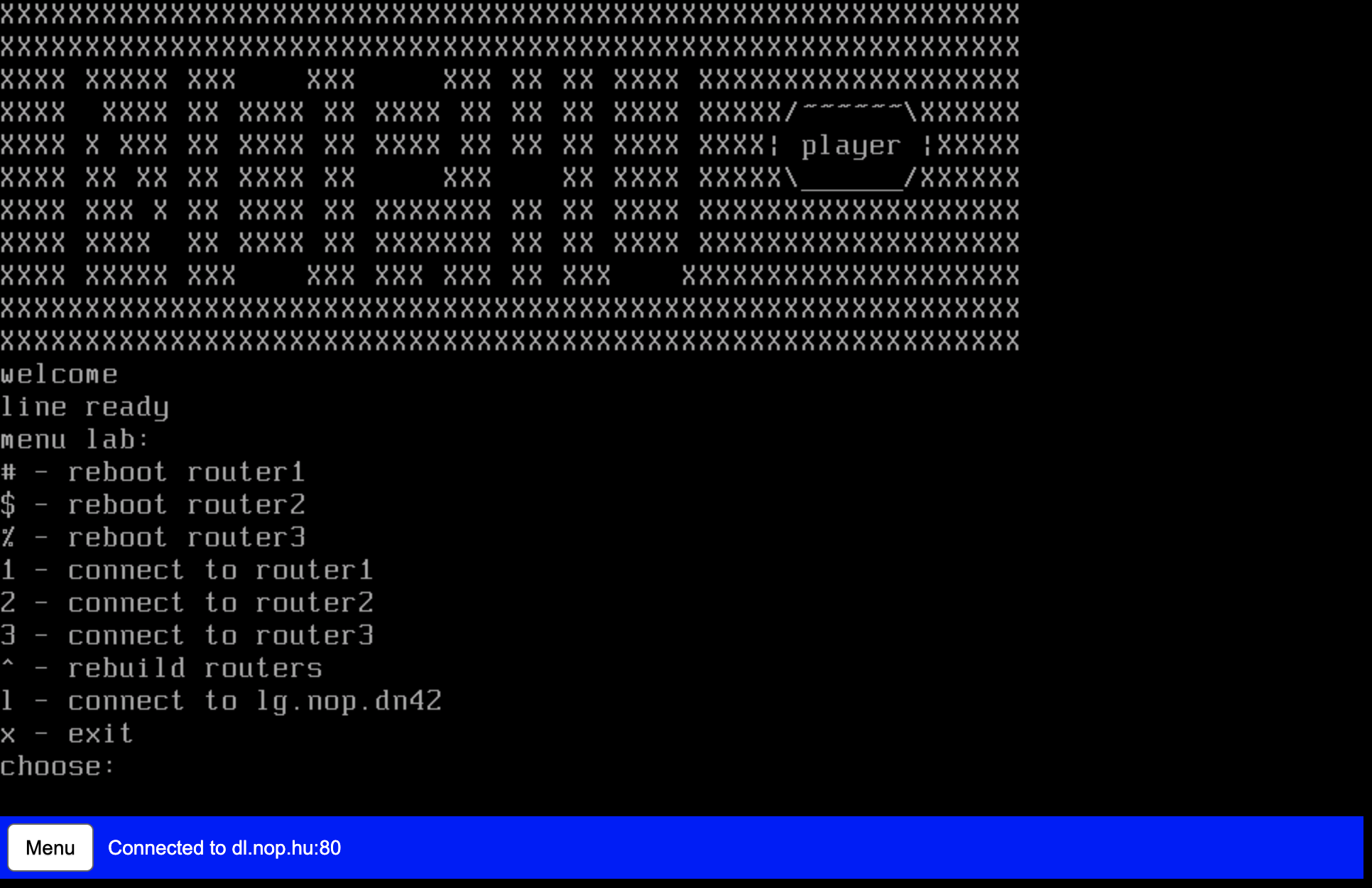All these modes are not new. IOS, IOS-XR, IOX-XE, NW-OX, JUNOS have their own config mode that are somewhat similar. In any case freeRouter config mode implementation is meant to address all needs from the network operators perspective. As you can observe, configure mode has an impressive list of mode. Feel free to try and use them according to your environment taste! Last but not least, you can play with these different mode from this sandbox: | Code Block |
|---|
| language | bash |
|---|
| theme | Midnight |
|---|
| title | type "telnet dl.nop.hu" in a terminal and choose "1" |
|---|
| telnet dl.nop.hu 1 ↵
Trying 193.224.23.5...
Connected to dl.nop.hu.
Escape character is '^]'.
XXXXXXXXXXXXXXXXXXXXXXXXXXXXXXXXXXXXXXXXXXXXXXXXXXXXXXXXXXXX
XXXXXXXXXXXXXXXXXXXXXXXXXXXXXXXXXXXXXXXXXXXXXXXXXXXXXXXXXXXX
XXXX XXXXX XXX XXX XXX XX XX XXXX XXXXXXXXXXXXXXXXXXX
XXXX XXXX XX XXXX XX XXXX XX XX XX XXXX XXXXX/~~~~~~\XXXXXX
XXXX X XXX XX XXXX XX XXXX XX XX XX XXXX XXXX| player |XXXXX
XXXX XX XX XX XXXX XX XXX XX XXXX XXXXX\______/XXXXXX
XXXX XXX X XX XXXX XX XXXXXXX XX XX XXXX XXXXXXXXXXXXXXXXXXX
XXXX XXXX XX XXXX XX XXXXXXX XX XX XXXX XXXXXXXXXXXXXXXXXXX
XXXX XXXXX XXX XXX XXX XXX XX XXX XXXXXXXXXXXXXXXXXXXX
XXXXXXXXXXXXXXXXXXXXXXXXXXXXXXXXXXXXXXXXXXXXXXXXXXXXXXXXXXXX
XXXXXXXXXXXXXXXXXXXXXXXXXXXXXXXXXXXXXXXXXXXXXXXXXXXXXXXXXXXX
welcome
line ready
menu lab:
... |
| Code Block |
|---|
| language | bash |
|---|
| theme | Midnight |
|---|
| title | type "ssh dl.nop.hu" in a terminal (any user/pass will do) and choose "1" |
|---|
| ssh dl.nop.hu -l random_user 1 ↵
Warning: Permanently added 'dl.nop.hu,193.224.23.5' (RSA) to the list of known hosts.
random_user@dl.nop.hu's password:
XXXXXXXXXXXXXXXXXXXXXXXXXXXXXXXXXXXXXXXXXXXXXXXXXXXXXXXXXXXX
XXXXXXXXXXXXXXXXXXXXXXXXXXXXXXXXXXXXXXXXXXXXXXXXXXXXXXXXXXXX
XXXX XXXXX XXX XXX XXX XX XX XXXX XXXXXXXXXXXXXXXXXXX
XXXX XXXX XX XXXX XX XXXX XX XX XX XXXX XXXXX/~~~~~~\XXXXXX
XXXX X XXX XX XXXX XX XXXX XX XX XX XXXX XXXX| player |XXXXX
XXXX XX XX XX XXXX XX XXX XX XXXX XXXXX\______/XXXXXX
XXXX XXX X XX XXXX XX XXXXXXX XX XX XXXX XXXXXXXXXXXXXXXXXXX
XXXX XXXX XX XXXX XX XXXXXXX XX XX XXXX XXXXXXXXXXXXXXXXXXX
XXXX XXXXX XXX XXX XXX XXX XX XXX XXXXXXXXXXXXXXXXXXXX
XXXXXXXXXXXXXXXXXXXXXXXXXXXXXXXXXXXXXXXXXXXXXXXXXXXXXXXXXXXX
XXXXXXXXXXXXXXXXXXXXXXXXXXXXXXXXXXXXXXXXXXXXXXXXXXXXXXXXXXXX
welcome
line ready
menu lab:
# - reboot router1
$ - reboot router2
% - reboot router3
1 - connect to router1
2 - connect to router2
3 - connect to router3
^ - rebuild routers
l - connect to lg.nop.dn42
x - exit
choose:1 - attach vdc lab1
yourname#
yourname#configure ?
<cr>
banner - edit the banner
editor - configure from editor
file - append to running configuration
network - append to running configuration
overwrite-network - overwrite the running configuration
reapply - !!!EXPERiMENTAL!!! try to reapply current configuration
reload - overwrite the startup configuration
replace - overwrite the running configuration
revert - revert to startup configuration
rollback - configure within auto-revert session
startup - edit the startup configuration
terminal - configure from this terminal
viewer - view current configuration
yourname#configure
... |
In order to exit the sandbox session use the following escape sequence: Ctrl-c + Ctrl-x Another method to access the sandbox, by By click here, this will open a terminal webapp into your browser: 

| 
